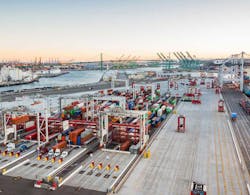As the ships get larger and trade expands globally, the robots are poised to step up to the challenge.
At TraPac LLC’s Los Angeles terminal 24 giant red robots push cargo containers along the dock, moving boxes to other robots who place in them in precise locations.
This technology can reduce the amount of time ships spend in port while improving productivity by 30%, as reported by Erica Philips of the Wall Street Journal.
“We have to do it for productivity purposes, to stay relevant and to be able to service these large ships,” said Peter Stone, a member of TraPac’s board told the Wall Street Journal. This cargo terminal is one of four in the U.S.
The port of Long beach is getting into the game as it will soon open an automated terminal. The terminal will cost $1 billion and be able to handle 3.3 million 20-foot container units—nearly half of the entire port’s volume last year.
But not everyone is happy about this automation.
Labor unions have resisted the technology as some studies show that robotic cargo handling can reduce the need for longshore labor by as much as 50%.
Read the full article.
